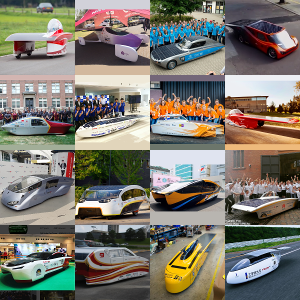30 days to go to the start of this years World Solar Challenge. The student teams from all over the world arrive in Australia. They wait to receive their their batteries, their gear and their cars. However transport and customs take time.
Teams from outside Australia that haven’t shipped their car yet, certainly feel pressure to get the solar car to Darwin in time. Although the cars themselves can reach Australia quickly by air freight, the batteries will not. They must be shipped and customs want to see them closely before they are allowed to enter the continent down under. Bochum has excellent logistics and is already unpacking the battery container. What a pity that the blue.cruiser is still missing. When it arrives the most important questions are: In what condition is the car after the transit? Are there serious damages? How long does it take to repair them? Only Australian teams still have time to build the car. Eight teams (from USA(2), Columbia, Russia, Sudan, Saudi-Arabia, Egypt and Siam) drew back their intended participation. Who knows, whether all left 42 solarcars will make it to the starting line until October 8th?
Already October first the participants will receive a welcome at the “Darwin Waterfront BWSC Festival”. The office opens even 5 days earlier. That is necessary because all cars have to pass the scrutineering before they are allowed to start. Static scrutineering begins at October 3rd, dynamic scrutineering is at October 7th. Just like the qualifying at Formula 1 races the dynamic scrutineering takes place on a racetrack where the fastest lap counts for the first starting place at the world solar challenge.
Technical Details
The recently unveiled vehicles show that even between the top solar car teams there are different concepts in car design and technology. For top challenger class teams (Michigan, Tokai, Kogakuin and Cambridge), build very small and long rocket style cars. Michigan’s rocket is only one meter wide and high but 5 meter long! The other top teams (Nuon, Punch, Stanford, Twente) operate with a solid catamaran design: Between the wheel cases is a tunnel that is covered by the solar array. The wheel cases contain the driver and the battery. The size of the car depends on the used technology: Nuon, Punch, Michigan and Cambridge use gallium-arsenid multijunction cells. Their array is limited to 2,64 m². The race cars from Stanford, Twente, Tokai und Kogakuin use an area of 4 m² for their array, because the use silicon cells with less efficiency.
Sustainability is Motor not only for the Motor
cruiser-class cars are not easy to categorise. Most of the cars have four or five seats. On group of cars (Eindhoven, Lodz, Iowa und Apollo) is designed like a familiy van, while the other group (Bochum, Sophie, Sunswift) will start with a car that looks like a typical sports car. Technical details will be discovered later. Bochumer showed some interesting sustainable details. The seats are covered with leater from pineapple leaves, the inside surface of the car is made from linen.

